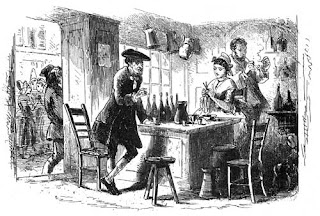In my Ravelings column in the Fall 2011 Interweave Knits, I write about knitters in literature. This is by way of an addendum.
Les Tricoteuses
Whenever I’m reading a book in an airport, my fellow travelers give me a wide berth.
But when I bring out my knitting, the vibe changes. Suddenly, the empty seats beside me are occupied by the curious and the sentimental swept up in memories of grandma knitting, Aunt Bee and her crochet, Mama and her quilting.
Women knitting in public did not always invite such happy reveries, however. In fact, a couple of hundred years ago les tricoteuses, the knitters of Paris, were demonized, condemned as dangerous subversives, handmaids of Lady Guillotine.
The knitters were the first to rebel in the 1780’s when living conditions for the working people of France became unbearably severe. Marching to the palace at Versailles, the women demanded bread. When Marie Antoinette suggested they eat cake instead, the French Revolution was ignited, and the brave working-class women of Paris were celebrated as heroines.
During the Reign of Terror, however, with the revolutionaries in power, the market women continued to protest in favor of the poor. The new regime found them an unwelcome irritant and made it illegal for them to attend government meetings.
In protest, the women gathered at the public site of executions, standing for hours witnessing the beheadings, knitting silently through them all, refusing to disappear from public life.
Some observers of the Revolution claimed les tricoteuses had been hired by the executioners to fill the role of witnesses to their ghastly work, and other accounts described them as gleefully celebrating the deaths of the wealthy and privileged. That’s the version Dickens relied on when he created his immortal character Madame Defarge who knits implacably through A Tale of Two Cities.
Late in the novel, in a chapter entitled “The Knitting Done” we learn that Thérèse Defarge is a revolutionary spy who eavesdrops on conversations in her wine shop, recording the names of her enemies in her stitches.
The “terrible woman had knitted when he talked with her,” remembers Sydney Carton, “and had looked ominously at him as her fingers moved.” She brings her knitted ledger along as evidence when she testifies against the novel’s hero, Charles Darnay.
Sometimes, when I’m knitting at the dentist’s office near a wheeler-dealer shouting all his financial details into his cell phone, I enjoy a little Madame Defarge fantasy. What if I recorded all these numbers into my fair isle pattern? No one would suspect a sweet little grey-haired lady of corporate espionage. As Agatha Christies’s Miss Marple shows, a woman knitting can pick up a lot of information.
In fact, Miss Marple is just another version of the tricoteuse. Acting as witness, prosecutor, and judge, she holds court from behind her needles and pink wool. Listening and observing, she stays out of the mischief going on around her, recording and assembling her evidence until she lays it all out in a scene at the end of the novel, like a lace knitter blocking a shawl, when the tangle of threads opens into a complex geometrical design.
Every time we sit in a coffee shop or a park with our knitting, we bring history with us. There’s a node of timelessness wherever we station ourselves, and the world, like a kid on a skateboard, sails by, glances at our quiet motions, and careens on its path. In any setting, the knitter is a silent witness to the moving scene, focused yet open, listening, connecting one strand to another as she contemplates the intricate loops that hold the world together.

3 comments:
Thanks for correcting the image of Hollywood's version of Dicken's knitter, which is the one that comes to my mind when I think of the old French knitter cackling while a bloody head drops into a basket. Knitters as witnesses, spys, and detectives makes me feel just a little cool, which rarely happens.
I was just reading "The Veiled One: an Inspector Wexford Mystery," where Ruth Rendell, the author, writes that a suspect's "pullover was of a darker grey with a cable pattern but errors had been made in the knitting of the cables. Burden found himself compulsively staring at one of these flaws up near the left shoulder, where the knitter in twisting the cable had passed the rib over instead of under the work."
I tend to insert an "error" somewhere in my knitting just to show that it's hand knit, but I guess I'd better watch myself.
Also, I figure that Madame DuFarge used an early binary system (knit, pearl as opposed to "1" and "0").
Thank you for this. I am a knitting lit and writing teacher in Alabama. I look forward to seeing and reading more of your delightful work.
Post a Comment